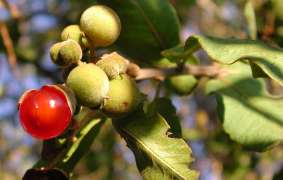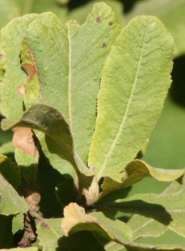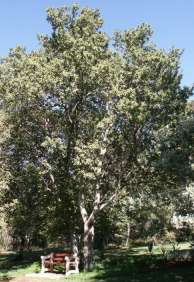Pappea capensis
Pappea capensis Eckl. & Zeyh.
Family: Sapindaceae
Common names: jacket plum, Indaba tree, bushveld cherry (Eng.); doppruim (Afr.); umqhokwane, umvuna, indaba (Zulu); ilitye, umgqalutye (Xhosa); mongatane, mopsinyugane (Northern Sotho); liletsa (Swati); xikwakwaxu, gulaswimbi (Tsonga)
SA Tree No: 433
Introduction
The red fruit of this tree is a tasty treat for humans and a firm favourite with birds and animals. A fine oil is extracted from the seeds. The jacket plum is related to the litchi and is a natural addition for the bird or wildlife garden. It is easily cultivated, although slow-growing in colder climates.

Description
Description
The jacket plum is a long-lived, hardy, evergreen, small to medium tree with a height of 2-8 m. Under ideal conditions it can grow at a moderate rate but can be slow-growing under dry and/or cold conditions.

The leaves are simple and oblong, hard-textured and wavy. The leaf margin may vary from sharply toothed (especially in young growth) to almost smooth in mature growth. The greenish flowers are borne on catkins in the axils of the leaves, followed by round green velvety fruits which split open to reveal bright red flesh with a dark brown to black seed imbedded within.
Distribution and habitat
Distribution description
Pappea capensis is widespread in southern Africa from the Northern Cape through the drier Karoo, Eastern Cape, KwaZulu-Natal, to the northern provinces, as well as Mozambique, Zimbabwe and northwards into eastern and southern tropical Africa. It naturally occurs in bushveld, riverine thicket, wooded grassland and rocky outcrops in grassland as well as scrub veld and is often found on termite mounds. Due to its wide distribution range it is well suited to cultivation in a wide variety of climatic conditions.
Derivation of name and historical aspects
History
The generic name Pappea is named after a German physician and plant collector Carl Pappe, while the specific name capensis refers to southern Africa. Pappea capensis belongs to the same family as the popular fruit, the litchi. The family is represented is South Africa most notably by the false currants (Allophylus spp.), the well-known and widely cultivated sand olive (Dodonaea viscosa) and the bushveld red-balloon (Erythrophysa transvaalensis).
This species was previously known as two separate varieties (Pappea capensis var. capensis and P. capensis var. radlkoferii). However, it is now widely accepted that it was just regional variation which resulted in confusion between an arid form from drier areas and a more lush form from regions of higher rainfall.
Ecology
Ecology
The fruit is eaten by various frugivorous birds and animals which in turn distribute the seeds in their droppings. The leaves are browsed by game such as elephant, giraffe, kudu, nyala, bushbuck, and grey duiker as well as domestic stock animals.
The jacket plum has also been recorded as the larval food plant to the caterpillars of the following butterflies of southern Africa:
Common hairtail butterfly (Anthene definita definita) Brown playboy butterfly (Virachola antalus) Pearlspotted charaxes (Charaxes jahlusa) Gold-banded forester (Euphaedra neophron)
The sweetly scented flowers attract a wide variety of insects which in turn attract many birds. The seed is parasitized by a small, bright red bug (Leptocoris hexophtalma) which sucks the oil from the seed on the ground below the tree.
Uses
Use
The delicious and very juicy fruit with a tart flavour is used to make preserve, jelly, vinegar and an alcoholic drink.
Fragrant non-drying golden yellow oil is extracted from the roasted seeds. There are reports of it being used for oiling rifles. It is also used as a purgative and for lubrication, as a cure for ringworm, to restore hair, as well as for making soap.
Leaves, bark and the oil extracted from the seed are used medicinally against baldness, ringworm, nosebleeds, chest complaints, eye infections, and venereal disease. Bark is also used in protective charms that are sprinkled on the ground. Some research has reported that the leaves are very effective in killing snails. Infusions of the bark are also used by Kenyan Masai warriors to gain courage as well as an aphrodisiac and a blood-strengthening tonic. The root is used orally or as an enema and as a purgative for cattle.
Lobengula's Indaba tree, which stands in the state house in Bulawayo in Zimbabwe, is an ancient specimen of Pappea capensis.
The wood is hard, light brown with a reddish tint, tough and heavy with a twisted grain. There is apparently little difference between the heartwood and the sapwood. The stems seldom attain significant girth and therefore do not yield much useable wood. It is, however, used to make sticks, poles, cattle yokes, furniture and kitchen utensils. This tree is still used as an important source of traditional medicine today.
Growing Pappea capensis
Grow

The jacket plum is a worthy addition to any garden no matter what part of the country you live in. It can tolerate both cold and heat as well as prolonged periods of drought. It may be used as a specimen tree or as a focal point. Its attractive pale grey stem often has patches of darker colours. It is useful as a street tree or for shade in parking lots as it does not have an aggressive root system. It is also well suited to being employed as part of a mixed screen or wind barrier or as part of a natural bushclump in a wildlife-friendly garden or in large landscapes such as parks and golf courses. As it seldom attains tremendous dimensions it also lends itself to being used in townhouse gardens. It develops a closed, dense crown under cultivation in areas of higher rainfall, which creates a cool shady place for a garden bench.
The new leaves are an attractive pinky-bronze when they emerge in spring, this contrasts well with the dark green of the old leaves making an attractive display.
The trees flower from September to May (southern hemisphere) and the rather special fruit is produced from December to July. The dense crown is popular with nesting birds as it provides a concealed and sheltered nesting sites.
Seed should be collected from the ripe fruits. Remove the red flesh. Store or sow immediately. Sow seed in trays using a well-drained seedling mixture with some river sand added. The seed should be pressed into the medium and covered with approximately 5 mm of sand or seedling medium. Keep the trays in a warm and lightly shaded position until germination, which may take from six to ten weeks under ideal conditions. The seedlings are best left in their trays until they are approximately 20-50 mm tall before planting out, taking care not to bruise or damage the young taproot.
Nursery-grown plants adapt well to cultivation and respond well to organic and synthetic horticultural fertilizers. Saplings are slow-growing especially when young but growth increases as the tree matures. Growth is also considerably quicker in warmer climates or warmer positions of the garden.
References
- Coates Palgrave, M. 2002. Keith Coates Palgrave Trees of southern Africa, edn 3. Struik, Cape Town.
- Hankey, A. 1999. Creating bush-clumps and exclusion areas in out of play areas of golf courses and large estates. Turf & Landscape Maintenance No. 14.
- Hutchings, A. 1996. Zulu medicinal plants: an inventory. University of Natal Press, Pietermaritzburg.
- Kroon, D.M. 1999. Lepidoptera of southern Africa, host-plants and other associations. Lepidopterists Society of Southern Africa, Johannesburg.
- Migdoll, I. 1987. Field guide to butterflies of southern Africa. Struik, Cape Town.
- Palmer, E. & Pitman, N. 1972. Trees of southern Africa, vol. 2. Balkema, Cape Town.
- Pooley, E. 1993. The complete field guide to trees of Natal, Zululand and Transkei. Natal Flora Publications Trust, Durban.
- Schmidt, E., Lötter, M. & McCleland, W. 2002. Trees and shrubs of Mpumalanga and Kruger National Park. Jacana, Johannesburg.
- Venter, S. & Venter, J. 1985. Making the most of indigenous trees. Briza Publications, Pretoria.
Credits
Andrew Hankey
Walter Sisulu National Botanical Garden
June 2004
Plant Attributes:
Plant Type: Tree
SA Distribution: Eastern Cape, Free State, Gauteng, KwaZulu-Natal, Limpopo, Mpumalanga, North West, Northern Cape, Western Cape
Soil type: Sandy, Clay, Loam
Flowering season: Spring, Early Summer, Late Summer, Autumn
PH: Neutral
Flower colour: Green, Yellow
Aspect: Full Sun
Gardening skill: Easy
Special Features:
Horticultural zones











Rate this article
Article well written and informative
Rate this plant
Is this an interesting plant?
User Comments
Molefe Mabiletsa, South Africa
February 28, 2018 at 8:58 PMHi. I planted two of these plants early 2014 and they haven't flowered yet. I live in Benoni it is a very cold area. Please advice if they should be flowering yet or not. Maybe I am doing something wrong. The one plant is about 2 meters tall and the other 1.5 metres
Alice Notten
March 06, 2018 at 10:41 AMHi Molefe, you are not doing anything wrong, they tend to be much slower growing in colder areas such as the Highveld. You will have to be patient for a few more years.
Let us know when they do eventually flower.
Login to add your Comment
Back to topNot registered yet? Click here to register.